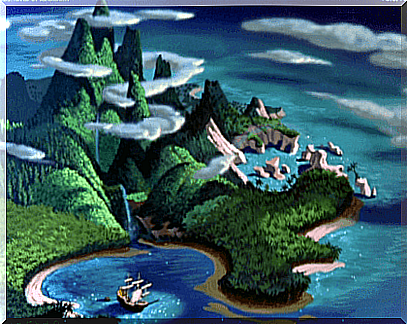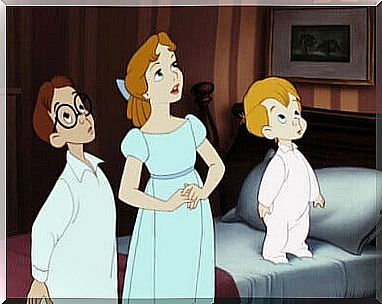Peter Pan is a well-known British play by writer James M. Barrie. The work was aimed at a children’s audience and premiered in London in 1904. Before becoming a play, the character Peter Pan appeared in a novel by Barrie; in this first version, Peter lived in London and all the boys were half bird, which is why they could fly.
Barrie has been improving his story and adding new features that will be seen in the theatrical work. He emphasizes the introduction of magic dust as responsible for the ability to fly, something that had to be included given the accidents that were taking place in the city by children who believed they could fly.
Barrie’s inspiration was Kensington Gardens in Hyde Park, where he used to spend a lot of time frequented by the Llewelyn Davies family, whose children used to play in the gardens and inspired the story.
If we go to London and visit Hyde Park, we will find the Peter Pan statue in the aforementioned gardens. This statue is not there by chance, being placed there by the author of the work in 1912 as a gift to the children of London, placing it in the place where Peter landed in the first version of the work. In addition, Barrie decided to assign the rights to the work to the Great Ormond Street Children’s Hospital in London.
Without a doubt, Peter Pan’s legacy seems endless and has given way to a multitude of adaptations in both theater and film. Today we’re going to focus on the possibly most iconic version, the 1953 Disney adaptation.
Neverland
Neverland is a remote island that can be accessed by flying to the highest sky, after which it is necessary to “turn the second star to the right, flying until dawn”. It is a place where there are no laws and children have no responsibilities, they spend most of their time playing and having fun.
This island may, in part, remind us of Pinocchio’s Isle of Pleasures, a film that makes reference to Peter Pan . On both islands, children don’t want responsibilities or grow up, they are remote places where adults don’t have access and where they can do whatever they want. However, unlike Pinocchio, the boys who inhabit Neverland are called Lost Boys, those who have not been claimed by anyone.

The island is home to fantastic creatures such as mermaids and fairies, but also Indians and pirates. The more time they spend in Neverland, the more difficult they will have to get out, recover their lives and their memories.
We can understand Neverland as an idyllic place where anything is possible, a place full of adventure and fun. However, it is also a trap, as boys cannot grow up and never reach maturity. As a result, they have short-lived memories.
Wendy, the reason for maturity
Wendy lives with her family in London until, one night, Peter Pan shows up at her house and takes her, along with her siblings, to Neverland.
In the beginning Wendy is a girl like the others, and like her siblings, she is happy, excited about the idea of being able to fly and visit Neverland, so she accepts and starts her journey with Peter.
Peter and the lost children will see in Wendy a mother figure, a person who can take care of them and tell them stories. In Neverland there are no girls and therefore its inhabitants have no protection or maternal figure, so that will be Wendy’s job.

Little by little they will realize the importance of growing for their own personal development, accepting the adaptation. Wendy will become something of a mother to the Lost Boys, and eventually they will be convinced that they must move towards that growth.
Wendy is the female character we find in opposition to Peter. Wendy is a responsible girl who takes care of her younger siblings and wants to become a grown woman. Wendy is the rational and complementary part of Peter.
Peter Pan, the boy who didn’t want to grow up
Peter Pan is the protagonist, he is a boy who lives in Neverland and does not remember his past. He plays the role of leader of the Lost Boys because, even in this world without rules, the figure of a leader is necessary, and in this case, that role falls to Peter.
Peter is, moreover, the chosen one to save Never Land. He is always accompanied by Lost Boys and Tink, a very jealous and possessive little fairy.
In fact, Peter is a boy who is afraid to grow up, face problems and reach maturity. He looks very brave when he scorns and mocks Captain Hook, but he’s not brave enough to face real world life.
It has a limitless imagination, thanks to which it can fly. It’s cheerful and doesn’t see danger; his skills as a leader are truly amazing and he is the one who convinces Wendy and her brothers to visit Neverland.
This leadership and power of persuasion is seen when Peter Pan shows the boys that their thoughts will make them fly, as long as they believe. They need to believe that it’s possible and send out happy thoughts, this way, and with the help of the magic dust, they can fly like Peter.
The power to fly is something very much associated with imagination and freedom. Humanity seems to have always yearned for the flight of birds, perhaps because it is considered something unattainable and almost divine. When we are children, it seems that one of our greatest desires is precisely the ability to fly. Therefore, we see that Peter is a pure boy and without the interferences that come from the adult world. He unleashes his imagination and can fly.
Children’s imagination is really powerful and fascinating, however, by the intervention of adults, it is sometimes limited; that’s why Lost Boys and Peter Pan have an unusual imagination, as it hasn’t been affected by any adult for a long time.
Peter Pan has a very charismatic personality, but he is also a very carefree and distracted child, even losing his own shadow. Losing the shadow also shows the loss of your identity, a problem with accepting yourself, a kind of personality unfolding.
The shadow is like a mirror where we recognize ourselves, it is something connected to us and that belongs to us. However, Peter Pan constantly loses it, that is, he loses himself. Peter hides from his shadow, doesn’t control it, because it represents what he fears most: growing up.
This work has given rise to multiple interpretations and an infinity of adaptations. However, in addition, it served to name the well-known Peter Pan syndrome, which affects people who do not want to grow or reach maturity, and Wendy syndrome, people who are obsessed with satisfying others and who deep down fear rejection. Without a doubt, Peter Pan is one of the most iconic works in the UK.
 rancha.xyz Be free to choose their own route to self-knowledge, health and balance of body and soul.
rancha.xyz Be free to choose their own route to self-knowledge, health and balance of body and soul.




